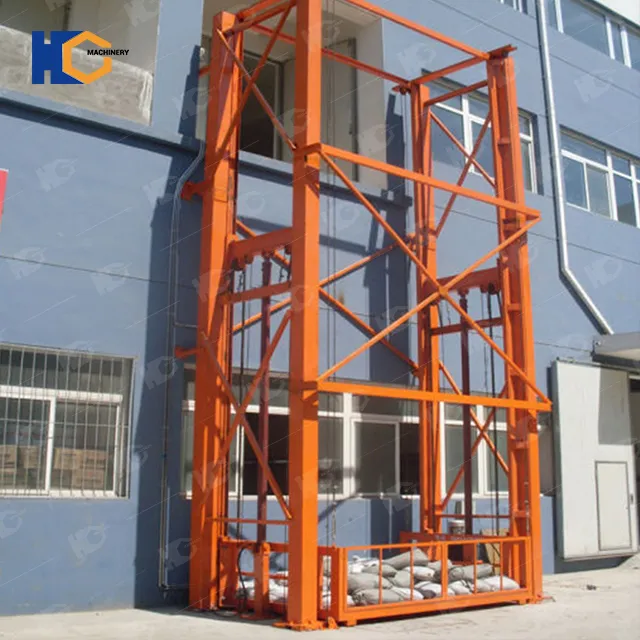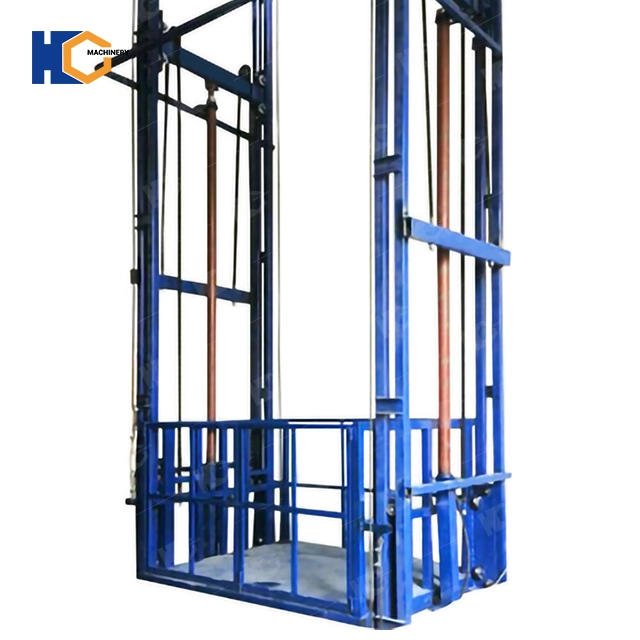Understanding the specifications of a cargo lift is crucial for selecting the right model for your needs. This guide will cover the key specifications to consider when choosing a cargo lift, ensuring you make an informed decision that meets your operational requirements.

What is a Cargo Lift?
A cargo lift, also known as a goods lift or freight elevator, is a mechanical system designed to transport heavy loads vertically between different floors. Unlike passenger elevators, cargo lifts are built to handle larger weights and bulkier items, making them ideal for industrial and commercial settings. These lifts come in various sizes, capacities, and configurations, tailored to specific needs.
Here’s a detailed specifications table for a cargo lift:
| Specification | Details |
|---|---|
| Load Capacity | 500 kg (1,100 lbs) to 10,000 kg (22,000 lbs) |
| Platform Size | 1.5m x 1.5m (5ft x 5ft) to 3m x 3m (10ft x 10ft) or custom sizes |
| Lift Height | 2m (6.5ft) to over 30m (98ft) |
| Speed | 0.1 m/s (20 ft/min) to 0.5 m/s (100 ft/min) |
| Drive System | Hydraulic, Traction, or Screw Drive |
| Safety Features | - Overload Protection - Emergency Stop - Door Interlocks - Backup Power - Safety Gates and Barriers |
| Installation Requirements | - Space for platform, shaft, and machine room - Structural support for lift and load - Dedicated electrical circuit |
| Durability and Materials | Steel, heavy-duty aluminum; built for daily use in industrial environments |
| Customization Options | - Custom platform sizes - Specialized safety features - Aesthetic customization (color, finish) |
| Maintenance | Regular maintenance required; warranty coverage typically included |
| Operating Temperature | Standard models typically operate within -10°C to 40°C (14°F to 104°F) |
| Noise Level | Varies by drive system; typically 60-80 dB during operation |
| Control System | - Manual or automatic controls - Keypad or touch-screen interface - Remote operation options available |
| Compliance and Certification | Meets local and international safety standards (e.g., ISO, CE, ASME) |
| Installation Time | Typically 2-4 weeks, depending on complexity |
This table provides an overview of the key specifications for a cargo lift, covering various aspects from load capacity to installation requirements.
Key Specifications of Cargo Lifts
When selecting a cargo lift, several specifications must be considered to ensure it meets the demands of your business. Below are the most important factors:
Load Capacity
Definition: Load capacity refers to the maximum weight that the cargo lift can safely carry in a single trip. This specification is crucial because it determines the types and quantities of goods that can be transported at one time.
Common Ranges: Cargo lifts typically have load capacities ranging from 500 kg (1,100 lbs) to over 10,000 kg (22,000 lbs). The specific capacity required depends on the nature of your operations. For example, a warehouse that regularly moves pallets of heavy goods may need a lift with a higher load capacity than a retail store moving lighter items.
Considerations: When choosing a cargo lift, consider the heaviest load you expect to transport regularly. It's also wise to select a lift with a capacity slightly higher than your maximum anticipated load to account for any future increases in demand.
Platform Size
Definition: The platform size of a cargo lift refers to the dimensions of the lift's loading area. This specification is essential for ensuring that the lift can accommodate the size of the items you need to transport.
Common Sizes: Platform sizes can vary widely, with standard dimensions typically ranging from 1.5 meters by 1.5 meters (5 feet by 5 feet) to 3 meters by 3 meters (10 feet by 10 feet) or larger. Custom sizes are also available to meet specific needs.
Considerations: Measure the largest items or pallets you plan to transport and ensure that the lift's platform size is sufficient. Additionally, consider the available space in your building and ensure that the lift will fit in the intended location without obstructing other operations.
Lift Height
Definition: Lift height refers to the maximum vertical distance the cargo lift can travel. This specification is determined by the number of floors or levels between which goods need to be transported.
Common Ranges: Cargo lifts typically have lift heights ranging from 2 meters (6.5 feet) for short transfers between adjacent floors, to over 30 meters (98 feet) for multi-story buildings.
Considerations: Ensure the lift height matches the vertical distance between the floors in your building. It's important to account for the ceiling height and any obstructions that might affect the lift's installation and operation.
Speed
Definition: The speed of a cargo lift refers to how quickly the platform moves between floors. Speed is an important factor, especially in high-traffic environments where time efficiency is crucial.
Common Ranges: Cargo lift speeds typically range from 0.1 meters per second (20 feet per minute) to 0.5 meters per second (100 feet per minute) or higher. The required speed depends on the frequency of use and the urgency of the goods being transported.
Considerations: While faster speeds can increase efficiency, they may also increase costs and require more robust safety features. Balance the need for speed with your budget and safety requirements.
Drive System
Hydraulic Drive: Uses a hydraulic piston to raise and lower the platform. This system is known for its smooth and quiet operation, making it ideal for buildings with low to medium lift heights. Hydraulic lifts are typically more affordable but may have slower speeds and lower energy efficiency.
Traction Drive: Uses a counterweight and ropes or belts to move the platform. Traction drives are suitable for taller buildings and offer faster speeds and greater energy efficiency. However, they are generally more expensive and require more maintenance.
Screw Drive: Uses a threaded screw to lift and lower the platform. This system is often used in smaller lifts and is known for its precision and low maintenance needs. However, it may not be suitable for very heavy loads or tall buildings.
Types: The drive system of a cargo lift is the mechanism that powers the movement of the lift. Common types include hydraulic, traction, and screw drives.
Considerations: The choice of drive system depends on the lift height, load capacity, and budget. Hydraulic systems are often preferred for shorter buildings, while traction systems are better for taller structures.
Safety Features
Overload Protection: Prevents the lift from operating if the load exceeds the maximum capacity, protecting the equipment and ensuring safety.
Emergency Stop: Allows the lift to be stopped immediately in case of an emergency, preventing accidents and damage.
Door Interlocks: Ensures that the lift cannot operate unless the doors are fully closed and locked, preventing accidental falls or injuries.
Backup Power: Provides power to the lift in the event of a power failure, allowing it to continue operating or return to the ground floor safely.
Safety Gates and Barriers: Prevents items from falling off the platform during operation, especially in open-sided lifts.
Considerations: Safety features are critical in ensuring the safe operation of the cargo lift. Make sure the lift you choose complies with local safety regulations and includes all necessary safety features.
Installation Requirements
Space: Consider the space required for the lift, including the platform, shaft, and machine room. Ensure that there is enough room in your building for the installation.
Structural Support: The building structure must be capable of supporting the weight of the lift and the maximum load it will carry. This may require additional reinforcement or modifications.
Electrical Requirements: Cargo lifts typically require a dedicated electrical circuit with sufficient power to operate the drive system. Ensure that your building's electrical system can accommodate the lift's requirements.
Permits and Regulations: Depending on your location, installing a cargo lift may require permits and adherence to specific building codes. Consult with local authorities and ensure that all legal requirements are met.
Durability and Maintenance
Materials: Cargo lifts are typically constructed from durable materials such as steel and heavy-duty aluminum, which can withstand the rigors of daily use.
Maintenance: Regular maintenance is essential to ensure the long-term performance and safety of the lift. This includes checking the drive system, lubricating moving parts, and inspecting safety features.
Warranty: Choose a lift that comes with a comprehensive warranty to cover any potential issues during the initial years of operation.
Customization Options
Tailored Solutions: Many manufacturers offer customization options, allowing you to tailor the lift’s specifications to your specific needs. This could include custom platform sizes, specialized safety features, or enhanced load capacities.
Aesthetics: Depending on your business’s branding or the location of the lift, you may want to customize the appearance of the lift, such as the color, finish, or design of the control panel.
Cost
Initial Purchase Cost: The cost of a cargo lift can vary widely depending on the specifications, brand, and customization options. Prices typically range from a few thousand to tens of thousands of dollars.
Operating Costs: Consider the long-term operating costs, including energy consumption, maintenance, and potential repairs. Hydraulic systems, for instance, may have lower initial costs but higher operating expenses due to energy consumption.
Installation Costs: Factor in the cost of installation, which can vary depending on the complexity of the project and any necessary building modifications.
Conclusion
Selecting the right cargo lift involves careful consideration of various specifications, including load capacity, platform size, lift height, speed, drive system, and safety features. By understanding these key factors and how they align with your operational needs, you can choose a lift that enhances your business’s efficiency and safety. Whether you’re equipping a warehouse, factory, or retail space, investing in a well-chosen cargo lift can provide significant long-term benefits, making the transportation of goods smoother, faster, and safer.
JNHC Lift: Leading Cargo Lift Manufacturer in China
JNHC Lift is a premier manufacturer of cargo lifts based in China. With our own state-of-the-art factory, we specialize in designing and manufacturing high-quality cargo lifts tailored to meet the specific needs of our clients. We offer a wide range of customizable options to ensure that our lifts perfectly match your operational requirements, whether you need a lift for industrial, commercial, or residential use.
At JNHC Lift, we are committed to providing durable, efficient, and safe lifting solutions that enhance your business’s productivity. With a focus on innovation and customer satisfaction, we deliver cargo lifts that you can rely on for years to come.

487.webp)
833.webp)
222.webp)
740.webp)
916.webp)
697.webp)